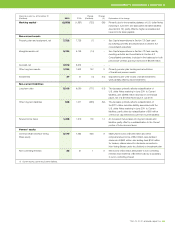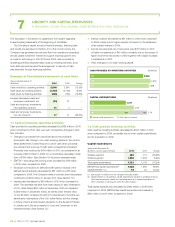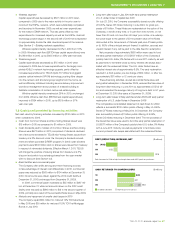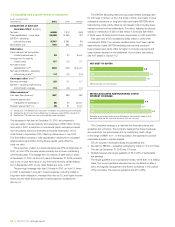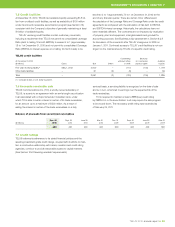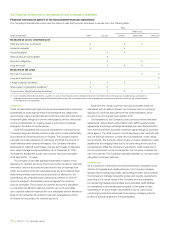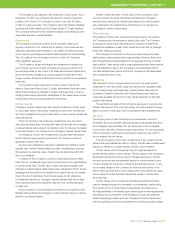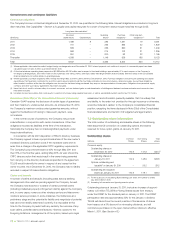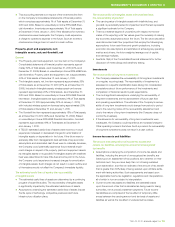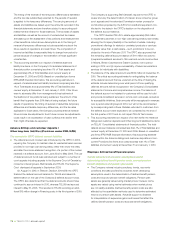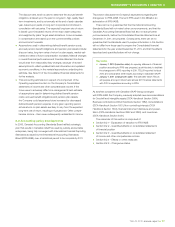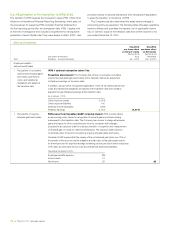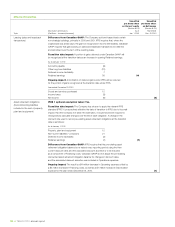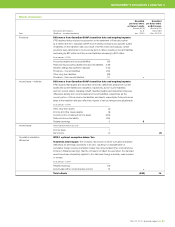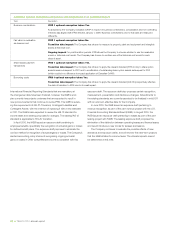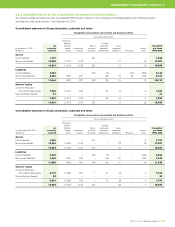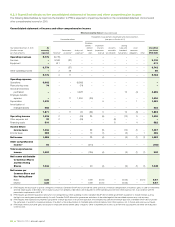Telus 2010 Annual Report Download - page 78
Download and view the complete annual report
Please find page 78 of the 2010 Telus annual report below. You can navigate through the pages in the report by either clicking on the pages listed below, or by using the keyword search tool below to find specific information within the annual report.
74 . TELUS 2010 annual report
.After changeover to IFRS on January 1, 2011, described and illustrated in Section 8.2, the Company’s critical accounting estimates affect line items
on the Consolidated statements of income and other comprehensive income items, and line items on the Consolidated statements of financial
position, as follows:
Consolidated statements of income and other comprehensive income (IFRS-IASB)
Other
comprehensive
Operating expenses
income (Item never
Goods and Employee Amortization subsequently
Consolidated statements of Operating services benefits of intangible reclassified
financial position (IFRS-IASB) revenues purchased expense Depreciation assets to income)
Accounts receivable X
Short-term borrowings (securitized accounts receivable) X
Inventories X
Property, plant and equipment, net X
Intangible assets, net, and Goodwill, net(1) X
Investments X
Price cap deferral account
Advance billings and customer deposits X
Provisions (non-current liabilities) X
Employee defined benefit pension plans X X(2) X(2) X
(1) Accounting estimate, as applicable to intangible assets with indefinite lives and goodwill, primarily affects the Company’s wireless cash generating unit.
(2) Accounting estimate impact due to internal labour capitalization rates.
Accounts receivable
General
.The Company considers the business area that gave rise to the
accounts receivable, performs statistical analysis of portfolio delin-
quency trends and performs specific account identification when
determining its allowance for doubtful accounts. This information is
also used in conjunction with current market-based rates of borrowing
to determine the fair value of its residual cash flows arising from
accounts receivable securitization. The fair value of the Company’s
residual cash flows arising from the accounts receivable securitization
is also referred to as its retained interest. As described further in
Section 8.2.1, proceeds from the sale of accounts receivable are
recorded as Short-term borrowings under IFRS-IASB, rather than
a reduction of Accounts receivable (or de-recognition) under
Canadian GAAP.
.Assumptions underlying the allowance for doubtful accounts include
portfolio delinquency trends and specific account assessments
made when performing specific account identification. Assumptions
underlying the determination of the fair value of residual cash
flows arising from accounts receivable securitization include those
developed when determining the allowance for doubtful accounts
as well as the effective annual discount rate.
.These accounting estimates are in respect of the Accounts
receivable line item on the Company’s Consolidated statements
of financial position comprising approximately 5% of Total assets
as at December 31, 2010 (4% as at December 31, 2009). Based
on unaudited pro forma IFRS-IASB financial information, Accounts
receivable are approximately 7% of Total assets at December 31,
2010 (approximately 6% at January 1, 2010). If the future were to
adversely differ from management’s best estimates of the fair value
of the residual cash flows and the allowance for doubtful accounts,
the Company could experience a bad debt charge in the future.
Such a bad debt charge does not result in a cash outflow.
Key economic assumptions used to determine the
fair value of residual cash flows arising from accounts
receivable securitization
.The estimate of the Company’s fair value of its retained interest
could materially change from period to period due to the
fair value estimate being a function of the amount of accounts
receivable sold, which can vary on a monthly basis. See Note 14
of the Consolidated financial statements for further analysis.
The allowance for doubtful accounts
.The estimate of the Company’s allowance for doubtful accounts
could materially change from period to period due to the
allowance being a function of the balance and composition of
accounts receivable, which can vary on a month-to-month basis.
The variance in the balance of accounts receivable can arise
from a variance in the amount and composition of operating
revenues, from a variance in the amount of accounts receivable
sold to the securitization trust and from variances in accounts
receivable collection performance.
Inventories
The allowance for inventory obsolescence
.The Company determines its allowance for inventory obsolescence
based upon expected inventory turnover, inventory aging, and current
and future expectations with respect to product offerings.
.Assumptions underlying the allowance for inventory obsolescence
include future sales trends and offerings and the expected inventory
requirements and inventory composition necessary to support
these future sales offerings. The estimate of the Company’s allow-
ance for inventory obsolescence could materially change from
period to period due to changes in product offerings and consumer
acceptance of those products.



